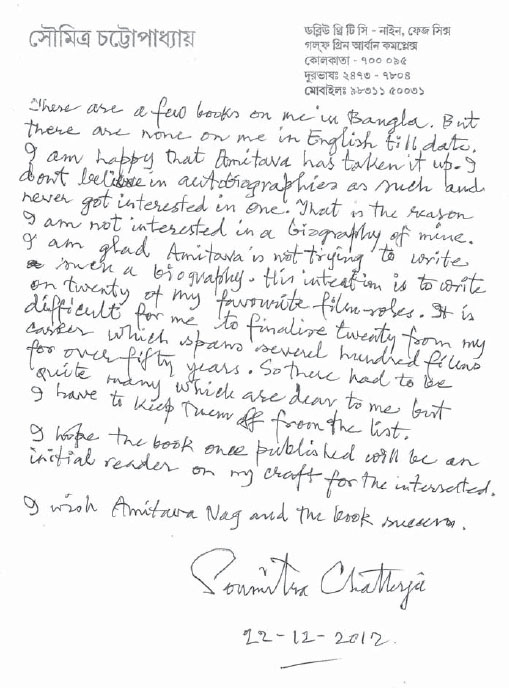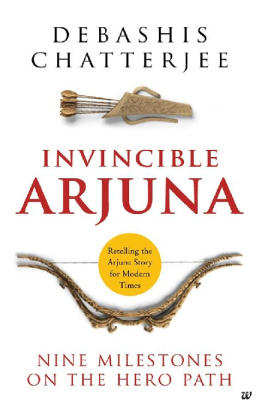Contents

Beyond Apu
20 FAVOURITE FILM ROLES
of
Soumitra Chatterjee
Amitava Nag

HarperCollins Publishers India
To my mother
and
to everyone who loves the creative genius of
Soumitra Chatterjee

CONTENTS
I have always been in doubt about my work. I always thought that the entertainment business was not worthwhile but time and again for more than fifty years I have been accepted, loved and made to feel as one of their own by my countrymen. I love them [viewers] and that is the reason I am doing cinema. I salute them as they have supplied me with energy and dedication of what I think is a good art.
Soumitra Chatterjee, Dadasaheb Phalke Award acceptance speech
The Indian film industry is the biggest in the world. Just the sheer volume of films being churned out annually goes to prove that. India is also a vast country of many languages and sub-cultures where films that reflect this rich cultural diversity do get made and released. Therefore, though there has been a constant attempt to label Bollywood as Indian cinema, Indian cinema goes beyond Bollywood to include a wide variety of films.
Bengal was one of the early centres of cinema in India and many of the film-makers who moved to Bombay were influenced by the early studios of Bengal. However, Indian cinema as a whole came into the limelight only in 1956 with Satyajit Ray and his epic Pather Panchali, though films like Neecha Nagar and Do Bigha Zameen had won international accolades earlier. Ray went on to become an international celebrity and he in turn inspired many other followers of his craft. Mrinal Sen, Ritwik Ghatak, Tapan Sinha and a few other contemporaries made different genres of films, which then began to represent Indian cinema to the world. In the 1970s, film-makers like Shyam Benegal, Adoor Gopalakrishnan and Buddhadeb Dasgupta gained wide national and international fame.
One of the actors seen most often in the critically acclaimed films of Bengal in the 1960s and 70s was Soumitra Chatterjee.
Soumitra debuted in Satyajit Rays Apur Sansar, the third film of the Apu Trilogy, and went on to become, arguably, Indias greatest actors, although being a Bengali, and therefore never attempting to breach Bollywood, meant that Soumitras name was known only within festival circuits or perhaps to those who were interested in critically acclaimed films no matter what the language. It is a moot point that a substantial number of non-Bengalis would have known of Soumitra from watching Rays films. According to celebrated international film scholar and critic Pauline Kael, Soumitra Chatterjee was Rays one-man stock company. Ray and the actor collaborated in fourteen feature films with a wide range of subjects. Other than Ray, Soumitra became the first choice for most eminent Bengali directors including Mrinal Sen, Tapan Sinha, Goutam Ghosh, Rituparno Ghosh and more recently, Aparna Sen.
Interestingly, he did not win a best actor award at the National Film Awards of India until as late as Podokkhep (2006). Soumitra has never concealed his distaste for awards conferred by the government, and had turned down the Padma Shri a couple of times. He has however been conferred with two international awards: the Officier des Arts et Metiers, one of the highest award for the arts, given by the French government, and the Lifetime Award at the Naples Film Festival, Italy, in 1999. It may be that his connection with the Left government of West Bengal went against him at the National Awards. However, in 2012 he was awarded the prestigious Dadasaheb Phalke Award (for 2011), the highest award in Indian cinema. In a personal conversation, he told me, I do not have much faith in the awards and the way they are given. Nor do I have much faith in the juries most of the time. Nor do I need an award at this stage of life. However, I did accept this award since I found it more or less free from the taint of politics and nepotism associated with all the other awards. If you see the other recipients of the Dadasaheb Phalke Award, you will find that barring one or two, everyone else is very deserving.
What makes Soumitra Chatterjee special? He is a cinema actor of the highest calibre who also went on to become a star. He has had a film career spanning over five decades. And even today he continues to be the first choice of most film-makers when they are looking for special histrionic abilities. Two important aspects are worth mentioning about his cinematic career. One, the professional rivalry between him and Uttam Kumar, and two, the shift in his choice of films across the decades.
When Soumitra started his career in the late 1950s/early 1960s, Uttam Kumar was an established star, bigger than all his contemporaries. The gorgeous Suchitra Sen was a perfect foil for Uttams eloquent and romantic personality. Meanwhile, Satyajit Ray was reeling out masterpiece after masterpiece, and for the first time, the audience had a glimpse of realism in Indian films. Uttam Kumar was quick to adapt to this trend, even if his chance to act in a Ray film came much later, in Nayak (1966).
By the mid-1960s, Soumitra became the thinking mans hero. He is an intellectual and a poet in real life. Even at the height of his stardom, he never confined himself to acting, but ventured into other streams of art like literature and painting. His association with the literary circles of Calcutta and with the legendary actor Sisir Bhaduri made him a natural favourite of students who frequented the iconic Coffee House at College Street, as well as the Bengali bhadralok, the middle class. They modelled themselves on him rather than on the more popular Uttam Kumar.
Uttam and Soumitra did a number of films together, including Jhinder Bandi (1961), Stree (1972), Aparichita (1969) and Devdas (1979). In Jhinder Bandi, Soumitra plays the sophisticated villain Mayurbahan and enjoys equal importance and screen time with Uttam Kumar. In all the other films except Devdas, Soumitra played second fiddle. Uttam played the confident male, going out and winning the girl and the fight, while Soumitra garnered popularity as the defeated other. It is this image that gave him his identity and which he developed with great sensitivity and understanding.
Soumitra Chatterjee was in fact a character actor who also became a star. This happened because of the influences on him in his early film career. In his first decade, the 1960s, he acted in more than forty films: seven films by Satyajit Ray, two by Tapan Sinha, three by Asit Sen and three by Mrinal Sen. Most of these films are very different from each other in form as well as in content. It is rare for a new actor to have the opportunity to work with so many talented directors. He probably realized that beating Uttam Kumar in the stardom stakes was next to impossible, given the esteem in which the mahanayak was held. As such, he concentrated on a body of work that would give him an identity distinct from Uttam Kumar.
The 1970s saw a change the political instability everywhere affected the film industry as well. In Bombay, the mantle shifted from Rajesh Khanna to Amitabh Bachchan. In Bengal, Uttam Kumar still held sway. However, as he moved more and more to character roles, keeping his star image intact, Soumitra did the opposite he accepted roles in more and more commercial films. The result was that he did only four Ray films and not a single other film by any other acclaimed director. He even shook a leg to the chartbusting












